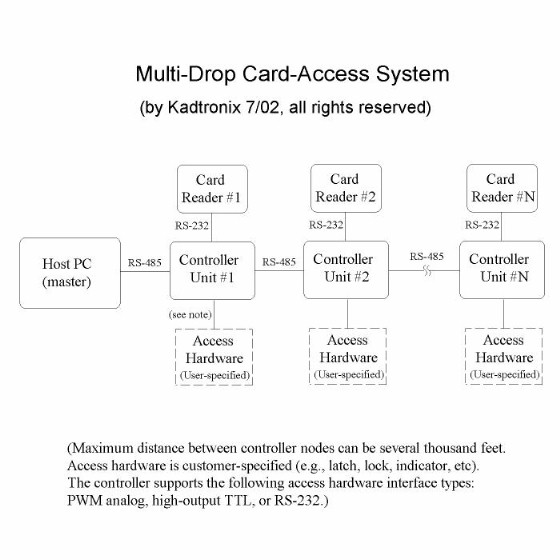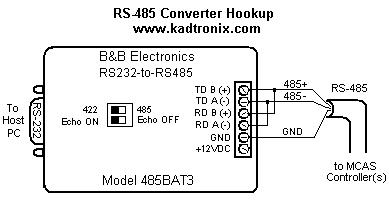What
card-readers may I use with MCAS?
Magnetic-stripe
(magstripe) and RFID proximity readers may be used with MCAS. The
following are compatible interfaces: serial RS-232 and TTL
(clock/data).
Wiegand interfacing has also been recently added. The following
tables
list some compatible readers. (Others are also possible. Contact
us for details.)
Magnetic-Stripe Readers
| Vendor |
Type |
Interface |
Part No. |
| MagTek |
Single-track (2) |
TTL |
21050002 |
| MagTek |
Dual-track (1,2) |
TTL |
21050004 |
| MagTek |
Single-track (2) |
RS-232 |
21040075 |
| MagTek |
Dual-track (1,2) |
RS-232 |
21040071 |
Proximity Readers
| Vendor |
Type |
Interface |
Part No. |
| ID
Enhancements |
HID ProxPoint Plus |
TTL |
6008 |
|
|
|
|
How
many MCAS controllers may I attach to a single RS-485 network?
Up
to 32 controllers may be attached on a single RS-485 cable.
Access
requires a single COM port on your PC and a RS232-to-RS485
converter.
Each controller is programmed with a unique address which allows it to
be accessed by the host PC. If you need to expand beyond 32
controllers,
you may do so using additional RS-485 networks. This requires
additional
COM port(s) and RS-485 converter(s).
What
is the cost of a complete MCAS system?
The
MCAS system is very affordable. Actual cost varies depending on
your
specific requirements. (For a price quote, click
here.) The following minimum components are required for
each MCAS implementation:
MCAS (BL1810)
controller (plus firmware programming)
Card-reader
(magstripe or proximity)
Host computer
(PC)
Host
software
RS232-to-RS485
converter
RS485
cabling
Power
supply
In addition,
depending on your application, you may also need one or more of the
following
additional items:
Field
wiring terminal board (recommended)
Door/gate
activation device (e.g., actuator, electric door strike, magnetic lock,
etc.)
Door-exit
switch
If you
would like a price quote, click here.
How
do I purchase a MCAS controller and how is it programmed?
Contact Kadtronix and provide a
brief description of your application
Be sure
to provide notification via e-mail
so we can expect your shipment.
Can
you do custom programming for my unique application?
Yes.
In fact, a large part of what we do involves custom software and
firmware.
If you've got a unique application, drop us a
note and provide a brief description of your requirements.
Do
you offer discounts for quantity purchases?
Yes. Contact us. for
details.
What
is a "reader station"?
A
reader station refers to the collective hardware in an access
area.
It typically consists of a MCAS controller, card-reader, power-supply,
and RS-485 cabling. In addition, a RS232-to-RS485
converter is required for host communication. (Only one
converter
is needed and shared by all reader stations on a RS-485 network.)
There may be additional equipment
including
door access hardware (e.g., electric door strike, magnetic lock,
etc.),
exit button, and the like. Up to 32 reader stations or access
areas
can be supported on a single RS-485 network.
Can
a reader station function standalone, without the host PC?
Yes. A host PC is required only for initial setup and
occasional
database maintenance. The MCAS controller needs no other
interaction
with the PC and runs autonomously. In fact, if the host RS-485
link
is lost or the PC shuts down, the MCAS controller remains completely
unaffected
and continues to perform its pre-programmed access function. Even
in the event of power loss, the MCAS controller's battery-backed
database
will be maintained and normal operation restored when power returns -
without
the need for restart or re-initialization by the host PC.
What
is the recommended supply voltage for the MCAS controller?
The
controller will accept a voltage range of 7.5 to 25VDC. However,
if you plan to implement a door-activation device, your supply voltage
must match the coil voltage of the activation relay. Our field
wiring terminal board (FWTB) includes an activation relay with a
coil
voltage of 12VDC. Therefore, 12VDC is recommended if you use the
FWTB.
What
is RS-485?
RS-485
is a communication protocol used for transmitting and receiving data
between
computers. Most PCs do not have RS-485 ports, but RS-232
instead.
Your PC probably has one or more COM ports which use the RS-232
protocol.
RS-485 is similar to RS-232 in some respects, but can handle much
greater
distances and features multi-drop networking capability. To use
MCAS
with a PC having only RS-232, you will need a device known as a RS232-to-RS485
converter. In MCAS, the RS-485 network consists of a
host
PC (master) and one or more MCAS controllers (slaves). The number
of controllers needed will be determined by the number of reader
stations your application requires. Regardless of the number
of controllers you choose to implement, only one RS32-to-RS485
converter is required per network. The diagram below provides
an illustration of a typical RS-485 network (converter not shown, but
assumed
to be part of the "Host PC" block):

Where
can I learn more abour RS-485?
To
learn more about RS-485, investigate the following online source:
RS485
Converters and Technical Data, B&B Electronics
Do
I need a converter for RS-485 communication?
Yes.
The converter allows your PC to communicate over the RS-485 cable to
the
MCAS controller(s). B&B
Electronics
supplies a number of converter types. They carry a number of
models
including internal converter cards, and port-powered external modules
(RS-232
and USB). The 485BAT3 is a good external, port-powered
converter.
The diagram below shows how to wire the converter:

What
if I require RS-232 or Ethernet host comm. instead of RS-485?
MCAS-1810
controllers support RS-232, RS-485, and Ethernet host
communication.
Do
you offer host control software?
Yes.
Low-cost MCAS host software is available. Click
here for details.
Where
can I obtain magnetic-stripe card-readers?
Magtek
offers an array of readers. Click here
for compatible models.
What
types of magstripe cards may I use with MCAS?
Track-2
compatible magnetic-stripe cards including ATM, driver's license,
grocery,
and credit cards. You may also use custom-encoded cards. We
can provide precoded (track-2) blank-face cards for your
application.
If desired, each card-face can be printed with its unique
card-number.
What's
the difference between TTL and RS-232 readers?
Operationally,
there is not much difference. Both types are compatible with
MCAS.
In fact, your application will not know the difference. TTL
(clock/data)
readers are generally less expensive since they provide no onboard
processing
for assembling card data. On card-swipe, there is no data latency as
they
deliver the data immediately to the controller (i.e., MCAS) to assemble
and decipher in realtime. RS-232 readers provide a standard, more
popular interface. On card-swipe, they assemble and decipher the
data, relieving the controller of this duty. The deiphered data
is
then delivered to the controller. (RS-232 readers introduce a
minimal
amount of data latency.) Both readers work well and are suitable
for use with MCAS.
Does
MCAS support proximity readers?
Yes.
HID manufactures a compatible reader. Click
here for details.
Where
can I obtain proximity readers and cards?
ID
Enhancements offers readers and cards. Click
here for compatible models
What
is the maximum distance between MCAS card-reader controller and host
computer?
RS-485
supports communication distances up to several thousand feet.
RS-232
communication should be limited to 100 feet or less.
How
many users can the MCAS controller store?
The
MCAS local database stores up to 1000 users. Programmers
with
Visual C++ experience can allow for more users by storing them on the
host's
hard-drive.
How
do I connect devices to the MCAS controller?
Kadtronix
provides detailed online wiring information including a field wiring
terminal
board (FWTB) for easy interfacing. Click
here.
Can
you customize MCAS firmware for my unique application.
Yes.
We realize that no one solution fits all needs. Kadtronix can
customize
MCAS controller firmware for your unqiue application. Want to
learn
how we can help? Contact us today.
What
are some typical MCAS applications?
ATMs
Hotel
room access
Employee
badging
Security
systems
Student
IDs
Industrial
automation
And more!
|


